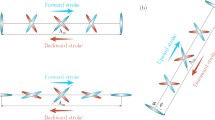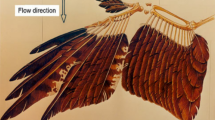Abstract
In the present study, flow structure around a live rhinoceros beetle in a tethered flight is investigated experimentally using a smoke-wire visualization technique in a wind tunnel with a free-stream velocity of 1.2 m/s, which is close to that of a typical flight speed. While varying the body angle (from 5 to 85°), the flow structures generated by the hindwings, elytra, and body are visualized along the spanwise direction. During the flapping period, the complex flow structures comprised leading-edge, trailing-edge, and tip vortices generated on the hindwing, but the flow structure is quite simple on the elytra (attached flow) and body (separated flow). As the body angle increases, these vortices convect in the downward direction, which matches the observation that the body angle of a hovering flight is larger than that of a forward flight. When the body angle matches the condition of forward flight, it is also found that the Strouhal number of a flapping hindwing is tuned to 0.4, which is known as an optimal value for thrust efficiency. Further, the effect of free-stream velocity (i.e., advance ratio) on the formation and evolution of these coherent vortical structures are investigated.
Similar content being viewed by others
References
T. Weis-Fogh, Quick estimates of flight fitness in hovering animals, including novel mechanisms for lift production, Journal of Experimental Biology, 59 (1973) 169–230.
C. P. Ellington, The aerodynamics of hovering insect flight. I. The quasi-steady analysis, Philosophical Transactions of the Royal Society of London B, 305 (1984) 1–15.
T. Weis-Fogh and M. Jensen, Biology and physics of locust flight. I. Basic principles in insect flight. A critical review, Philosophical Transactions of the Royal Society of London. B, 239 (1956) 415–458.
M. H. Dickinson, F. O. Lehmann and S. P. Sane, Wing rotation and the aerodynamic basis of insect flight, Science, 284 (1999) 1954–1960.
C. P. Ellington, C. Van den Berg, A. P. Willmott and A. L. R. Thomas, Leading-edge vortices in insect flight, Nature, 384 (1996) 626–630.
R. B. Srygley and A. L. R. Thomas, Unconventional lift-generating mechanisms in free-flying butterflies, Nature, 420 (2002) 660–664.
F. O. Lehmann and S. Pick, The aerodynamic benefit of wing-wing interaction depends on stroke trajectory in flapping insect wings, Journal of Experimental Biology, 210 (2007) 1362–1377.
Z. J. Wang, Dissecting insect flight, Annual Reviews of Fluid Mechanics, 37 (2005) 183–210.
W. Shyy, Y. Lian, J. Tang and H. Liu, Aerodynamics of Low Reynolds Number Flyers, Cambridge University Press, New York, USA (2008).
R. J. Bomphrey, N. J. Lawson, G. K. Taylor and A. L. Thomas, Application of digital particle image velocimetry to insect aerodynamics: Measurement of the leading-edge vortex and near wake of a Hawkmoth, Experiments in Fluids, 40 (2006) 546–554.
R. J. Bomphrey, T. Nakata, N. Phillips and S. M. Walker, Smart wing rotation and trailing-edge vortices enable high fre quency mosquito flight, Nature, 544 (2017) 92–95.
J. Kweon and H. Choi, Sectional lift coefficient of a flapping wing in hovering motion, Physics of Fluids, 22 (2010) 071703.
A. P. Willmott, C. P. Ellington and A. L. Thomas, Flow visualization and unsteady aerodynamics in the flight of the hawkmoth, Manduca sexta, Philosophical Transactions of the Royal Society of London B, 352 (1997) 303–316.
C. Koehler, Z. Liang, Z. Gaston, H. Wan and H. Dong, 3D reconstruction and analysis of wing deformation in free-flying dragonflies, Journal of Experimental Biology, 215 (2012) 3018–3027.
H. Park and H. Choi, Kinematic control of aerodynamic forces on an inclined flapping wing with asymmetric strokes, Bioinspi-ration and Biomimetics, 7 (2012) 016008.
B. Lee, H. Park and S. T. Kim, Three-dimensional wing behaviors of a rhinoceros beetle during takeoff flights, Journal of Mechanical Science and Technology, 29 (2015) 5281–5288.
S. Oh, B. Lee, H. Park, H. Choi and S. T. Kim, A numerical and theoretical study of the aerodynamic performance of a hovering rhinoceros beetle (Trypoxylus dichotomus), Journal of Fluid Mechanics (2019) (accepted).
N. S. Ha, Q. T. Truong, N. S. Goo and H. C. Park, Relationship between wingbeat frequency and resonant frequency of the wing in insects, Bioinspiration and Biomimetics, 8 (2013) 046008.
G. R. Spedding and P. B. S. Lissaman, Technical aspects of microscale flight systems, Journal of Avian Biology (1998) 458–468.
M. M. de Souza and D. E. Alexander, Passive aerodynamic stabilization by beetle elytra (wing covers), Physiological Entomology, 22 (1997) 109–115.
T. Q. Le, T. Van Truong, H. T. Tran, S. H. Park, J. H. Ko, H. C. Park and D. Byun, How could beetle’s elytra support their own weight during forward flight?, Journal of Bionic Engineering, 11 (2014), 529–540.
T. V. Truong, T. Q. Le, H. C. Park, K. J. Yoon, M. J. Kim and D. Byun, Non-jumping take off performance in beetle flight (Rhinoceros Beetle Trypoxylus dichotomus), Journal of Bionic Engineering, 11 (2014) 61–71.
L. C. Johansson, S. Engel, E. Baird, M. Dacke, F. T. Muijres and A. Hedenstrom, Elytra boost lift, but reduce aerodynamic efficiency in flying beetles, Journal of the Royal Society Interface, 9 (2012) 2745–2748.
P. E. Sitorus, H. C. Park, D. Byun, N. S. Goo and C. H. Han, The role of elytra in beetle flight: I. generation of quasi-static aerodynamic forces, Journal of Bionic Engineering, 7 (2010) 354–363.
T. Q. Le, D. Byun, Saputra, J. H. Ko, H. C. Park and M. Kim, Numerical investigation of the aerodynamic characteristics of a hovering coleopteran insect, Journal of Theoretical Biology, 266 (2010) 485–495.
T. Q. Le, T. V. Truong, S. H. Park, T. Q. Truong, J. H. Ko, H. C. Park and D. Byun, Improvement of the aerodynamic performance by wing flexibility and elytra-hind wing inter-action of a beetle during forward flight, Journal of Royal Society Interface, 10 (2013) 20130312.
K. Kitagawa, M. Sakakibara and M. Yasuhara, Visualization of flapping wing of the drone beetle, Journal of Visualization, 12 (2009) 393–400.
T. V. Truong, T. Q. Le, H. T. Tran, H. C. Park, K. J. Yoon and D. Byun, Flow visualization of rhinoceros beetle (Trypoxylus dichotomus) in free flight, Journal of Bionic Engineering, 9 (2012) 304–314.
H. Park and H. Choi, Aerodynamic characteristics of flying fish in gliding flight, Journal of Experimental Biology, 213 (2010) 3269–3279.
A. L. Thomas, G. K. Taylor, R. B. Srygley, R. L. Nudds and R. J. Bomphrey, Dragonfly flight: free-flight and tethered flow visualizations reveal a diverse array of unsteady lift-generating mechanisms, controlled primarily via angle of attack, Journal of Experimental Biology, 207 (2004) 4288–4323.
R. J. Bomphrey, G. K. Taylor and A. L. Thomas, Smoke visualization of free-flying bumblebees indicates independent leading-edge vortices on each wing pair, Experiments in Fluids, 46 (2009) 811–821.
E. L. McCullough and B. W. Tobalske, Elaborate horns in a giant rhinoceros beetle incur negligible aerodynamic costs, Proc. of the Royal Society of London, 280 (2013) 20130197.
M. H. Dickinson and K. G. Gotz, Unsteady aerodynamic performance of model wings at low Reynolds numbers, Journal of Experimental Biology, 174 (1993) 45–64.
T. Maxworthy, Experiments on the Weis-Fogh mechanism of lift generation by insects in hovering flight. Part 1. Dynamics of the ‘fling’, Journal of Fluid Mechanics, 93 (1979) 47–63.
G. K. Taylor, R. L. Nudds and A. L. Thomas, Flying and swimming animals cruise at a Strouhal number tuned for high power efficiency, Nature, 425 (2003) 707–711.
G. S. Triantafyllou, M. S. Triantafyllou and M. A. Grosenbaugh, Optimal thrust development in oscillating foils with application to fish propulsion, Journal of Fluids and Structures, 7 (1993) 205–224.
C. P. Ellington, The aerodynamics of hovering insect flight. III. Kinematics, Philosophical Transactions of the Royal Society of London B, 305 (1984) 41–78.
W. B. Dickson and M. H. Dickinson, The effect of advance ratio on the aerodynamics of revolving wings, Journal of Experimental Biology, 207 (2004) 4269–4281.
R. R. Harbig, J. Sheridan and M. C. Thompson, The role of advance ratio and aspect ratio in determining leading-edge vortex stability for flapping flight, Journal of Fluid Mechanics, 751 (2014) 71–105.
Acknowledgements
This research was supported by a grant to Bio-Mimetic Robot Research Center funded by Defense Acquisition Program Administration and by Agency for Defense Development (UD160027ID), and also by the NRF research program (2017R1A4A1015523) of the MSIT, Korea.
Author information
Authors and Affiliations
Corresponding author
Additional information
Recommended by Editor Yang Na
Boogeon Lee received his B.S. degree in mechanical engineering from Hanyang University, Seoul, Korea, in 2014. He is currently working toward his Ph.D. with the Multiphase Flow & Flow Visualization Laboratory, Department of the Mechanical Engineering, Seoul National University, Seoul, Korea. His research interests include insect flight, and fluid-structure interaction.
Sehyeong Oh obtained his B.S. degree at in mechanical and aerospace engineering from Seoul National University in 2014. He is currently working toward his Ph.D. at Turbulence, Flow Control & CFD Laboratory, Department of the Mechanical Engineering, Seoul National University, Seoul, Korea. His research interests include insect flight, aerodynamics, bio-mimetic engineering, and CFD.
Haecheon Choi obtained his B.S. and M.S. degrees at the Department of Mechanical Engineering, Seoul National University in 1985 and 1987, respect-tively. He received his Ph.D. from Stanford University in 1992. Dr. Choi is currently a Professor at the Department of Mechanical Engineering, Seoul National University. His research interests include turbulence, flow control, CFD, and bio-mimetic engineering.
Hyungmin Park obtained his B.S. degree and Ph.D. at the Department of Mechanical & Aerospace Engineering, Seoul National University, Korea, in 2000 and 2010, respectively. Dr. Park is currently an Associate Professor at the Department of Mechanical Engineering, Seoul National University. His research interests include multiphase flow, flow control with wettability-controlled surfaces, and fluid-structure interaction.
Rights and permissions
About this article
Cite this article
Lee, B., Oh, S., Choi, H. et al. Effect of body angle on the aerodynamics of a rhinoceros beetle: Smoke-wire visualization in a wind tunnel. J Mech Sci Technol 34, 209–218 (2020). https://doi.org/10.1007/s12206-019-1222-0
Received:
Revised:
Accepted:
Published:
Issue Date:
DOI: https://doi.org/10.1007/s12206-019-1222-0




